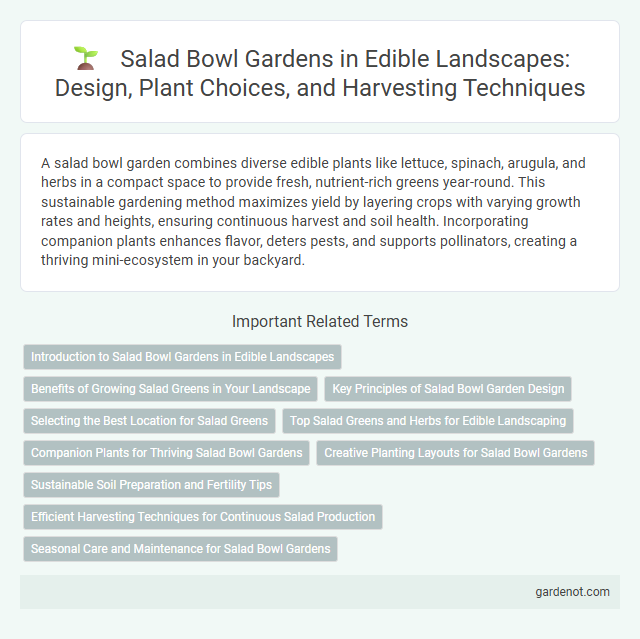A salad bowl garden combines diverse edible plants like lettuce, spinach, arugula, and herbs in a compact space to provide fresh, nutrient-rich greens year-round. This sustainable gardening method maximizes yield by layering crops with varying growth rates and heights, ensuring continuous harvest and soil health. Incorporating companion plants enhances flavor, deters pests, and supports pollinators, creating a thriving mini-ecosystem in your backyard.
Introduction to Salad Bowl Gardens in Edible Landscapes
Salad bowl gardens are compact, versatile edible landscapes designed for growing a variety of fresh, nutrient-rich salad greens and herbs in a small, accessible space. These gardens maximize yield by layering leafy greens, microgreens, and aromatic herbs, making them ideal for urban settings and home gardeners seeking sustainable food sources. Incorporating diverse plants like lettuce, arugula, spinach, and basil ensures a continuous harvest while enhancing soil health and biodiversity.
Benefits of Growing Salad Greens in Your Landscape
Growing salad greens in your edible landscape enhances nutritional intake by providing fresh, vitamin-rich produce directly from your garden. Incorporating a salad bowl garden promotes sustainable gardening practices, reduces food waste, and minimizes grocery costs. This method also supports biodiversity by attracting beneficial insects and improves soil health through diverse plant roots.
Key Principles of Salad Bowl Garden Design
Salad bowl garden design emphasizes diversity by incorporating a variety of leafy greens, herbs, and edible flowers to create a continuous harvest throughout the growing season. Spatial planning maximizes productivity by layering plants with different heights and growth habits, ensuring optimal sunlight exposure and airflow. Soil health is prioritized through organic amendments and mulching to retain moisture and enhance nutrient availability, supporting vigorous plant growth.
Selecting the Best Location for Salad Greens
Choosing the best location for a salad bowl garden involves prioritizing areas with full sun exposure, ideally 6 to 8 hours daily, to ensure robust growth of salad greens like lettuce, spinach, and arugula. Well-draining soil rich in organic matter enhances nutrient availability and prevents root rot, crucial for tender leaves. Proximity to a water source facilitates consistent irrigation, supporting continuous harvests throughout the growing season.
Top Salad Greens and Herbs for Edible Landscaping
Salad bowl gardens feature a variety of top salad greens and herbs that thrive in edible landscaping, including arugula, spinach, and kale, which provide vibrant colors and rich nutrients. Popular herbs such as basil, cilantro, and parsley add aromatic flavors and enhance the visual appeal of garden beds while promoting biodiversity. Incorporating these greens and herbs creates a sustainable, attractive landscape that supports continuous harvests and healthy eating habits.
Companion Plants for Thriving Salad Bowl Gardens
Companion plants like basil, chives, and radishes enhance the growth and flavor of salad bowl gardens by repelling pests and improving soil health. Leafy greens such as lettuce and spinach benefit from nearby marigolds and nasturtiums, which attract beneficial insects and deter harmful aphids. Integrating herbs and flowers supports a resilient ecosystem, promoting a thriving and productive edible landscape.
Creative Planting Layouts for Salad Bowl Gardens
Creative planting layouts for salad bowl gardens maximize space by combining various leafy greens, herbs, and edible flowers in layered, textured arrangements. Incorporating contrasting colors and heights, such as red lettuce, basil, and nasturtiums, creates visually appealing and functional designs that encourage biodiversity. Circular, spiral, or tiered planting patterns enhance accessibility and microclimates, promoting healthy growth and continuous harvesting.
Sustainable Soil Preparation and Fertility Tips
Salad bowl gardens thrive with sustainable soil preparation techniques such as incorporating organic compost, mulching with natural materials, and practicing crop rotation to enhance nutrient availability and soil structure. Using cover crops like clover or legumes can naturally fix nitrogen, improving fertility without synthetic fertilizers. Maintaining soil moisture through drip irrigation and avoiding soil compaction further promotes healthy root development and long-term garden productivity.
Efficient Harvesting Techniques for Continuous Salad Production
Salad bowl gardens utilize dense planting and succession planting techniques to maximize space and ensure a continuous supply of fresh greens. Efficient harvesting involves selective picking of outer leaves to promote regrowth, reducing waste and allowing multiple harvests per plant. Integrating lightweight tools and scheduled harvesting intervals enhances productivity and maintains optimal plant health for sustained salad production.
Seasonal Care and Maintenance for Salad Bowl Gardens
Salad bowl gardens require regular seasonal care to ensure continuous harvests, including consistent watering and nutrient replenishment tailored to cooler spring and fall temperatures. Removing faded or yellowing leaves promotes healthy growth and reduces disease risk while rotating crops helps maintain soil fertility and pest control throughout the year. Mulching with organic materials maintains moisture levels and moderates soil temperature, essential for the delicate greens preferred in salad bowl gardens.
Salad bowl garden Infographic

 gardenot.com
gardenot.com